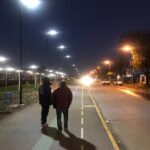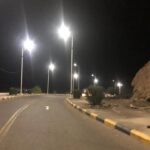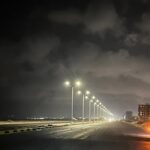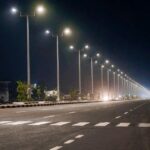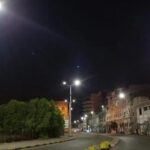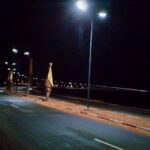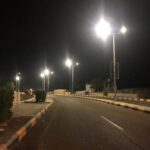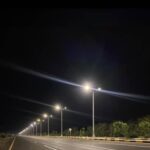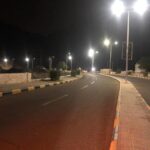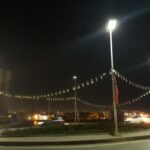Speaking of solar street lights, you may be confused that there are so many of them in the marketplace. The confusion is also in different types of designs and structures. The simple appearances of these products suggest that one can make your own. But how to make solar street light?
The full-split design features in most DIY guides since it is the foundation of the many solar street lights you will find in the market.
The complete model of a solar street light comprises of six main parts, and these are :
- The solar photovoltaic cell(s) or solar panel(s) – converts solar energy to electric power.
- Solar charge controller- regulates the electric charge leaving the PV module and entering the battery.
- Solar Inverter – converts the solar panel’s variable direct current (DC) to frequency alternating current (AC).
- Battery – Stores electric energy for use at night or in low ambient areas.
- Street lamp – Source of light.
- Cables and Pole – connectivity and support, respectively.
These components are readily available and sold separately. If you are serious about making your own solar street light, then you will need a DIY guide with you. Here one that you can use for your project.
The Solar Street Light Design
In design, you need to determine the power consumption of your system. The amount of brightness required to illuminate the area of interest will define the necessary lumen. The bulb or lamp you intend to use should give you the wattage.
Use the power requirement of the lighting source and the duration illumination to calculate the watt-hours of the battery and any component that consumes power. Now that you know the type of storage you need; it is easy to determine the PV module to be used in this project.
Knowing the watt-hours needed for the lights will help in the sizing of the battery. Using reliable electrical formulas, you can compute for the depth of discharge, nominal battery voltage, and the ampere-hour capacity of the storage device.
As for the PV module, you will need to multiply the total watt-hours by the loss factor to compensate for the energy loss in the system. The Watt peak, determined by the climate of the place and panel generation factor, will help you compute the number of PV modules you need. You will also need to calculate for the pane angle of tilt.
The amperage and voltage capacities of the PV arrays and the battery should help you select the type of solar charge controller. The sizing of your controller requires matching the power requirements of the solar panel and your choice of the energy storage device. The rule of thumb here is to ensure that you pick a controller that can handle the current from the PV module.
There is a lot of calculation required in the design section, which is essential in the sizing of the main components necessary to make your solar street light a success. In the end, you should know the number of solar panels you need to meet your lighting requirements. The information you get in design stage creates the technical specification of the system.
Solar Street Light Optimization
You need to optimize the main components of the street light to reduce costs and energy consumption in the system. To maximize your solar street light, you will have to consider the efficiency of the streetlight appliances. The lighting source can be optimized by using energy-efficient bulbs such as LED and CFL.
Besides ensuring that you are using a rechargeable and deep cycle battery, you need to choose the best storage technology. In most cases, lithium-ion batteries are the most commonly used in solar systems, but you can still use other battery types such as Lead-acid and gel cell batteries. The kind of storage you choose should be sufficient enough to power the electric appliances in the system during cloudy and severe weather conditions.
You can optimize your PV module by choosing one that is affordable and has a high solar energy conversion rate. There are two types of solar panels: poly-crystalline and monocrystalline. The monotype is considered to have a higher conversion rate compared to the polytype.
Optimization can also be achieved by ensuring that there are no energy losses in your wiring connection. For smart street lights, you will have to introduce sensory chips (motion, ambient daylight, or battery level) into the controller’s circuitry. The controller you use should be able to switch the system on or off where necessary.
As for the pole, it needs a lightweight material that gives it wind resistance. The pole must be strong enough to accommodate the weight of the components to be mounted on it. You will also need Interconnecting cables running from the solar panel, through the controller and the battery and finally ending at the lamps.
Generally, this phase ensures that your system has qualities such as low cost, durability, Eco-friendly, zero UV emissions, and Long Life. It ensures that you have a battery with the right capacity and long service.
How to Make Solar Street Light: Construction
Once you are done with the design and purchase of the main components for your solar street light project, you will need to assemble it together. Since you now have a picture of how your unit looks like, this should not take much of your time.
In this stage of your project, you will have to consider the mounting, the housing, and the wiring of the components. It is less costly to assemble everything on the ground before planting the system where you need it to be.
During the construction phase, your electrical and metalwork skills should help you do the wiring and mount the various devices, respectively. When installing the solar street light, use your design and solar or electrical standards to guide you.
You may need some assistance during the construction and installation process. Good practice demands that you test your equipment before installing it; otherwise, you may incur additional costs. When things get out of hand, feel free to consult an expert in solar street lighting.
Check out Solar Energy Street Light: Grid-Tied, Off-Grid or Hybrid?



